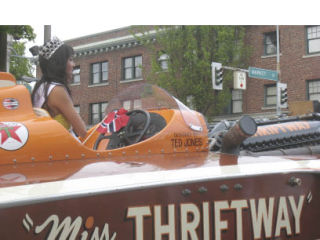This weekend, a replica of the 1950s hydroplane Miss Thriftway will take to the water in Lake Sammamish, skating on top of the water at 130 miles an hour.
The boat — a replica of the one made famous by Bill Muncey, one of the best hydroplane racers of the sport’s heyday — was created by 10 people, many Islanders, a labor of love by a group of men who relish the sport.
After working on the boat for nearly a decade, they’re now beginning to enjoy the fruits of their labor.
“It kind of makes an old guy a kid again,” said Islander Larry Fuller, Miss Thriftway’s main driver. “There’s a lot to watch for when you’re out there, especially with other boats. The boat actually handles beautifully, right from the day we launched it. It’s just beautiful; it corners beautifully.”
Miss Thriftway is built for business, said Steve Payne, Miss Thriftway’s crew chief and one of her owners. Its engine came out of a P-38 Lightning fighter jet from World War II. The boat is a little more than 28 feet long and weighs as much as a pickup truck, but has 2,000 horsepower.
“The World War II fighter engines were the finest engines ever built — that’s why they call them thunder boats,” Payne said.
All Vashon-built, the vintage-style boat has no seat belt or canopy, because the team building the boat wanted the replica to be as true to the original as possible.
“Our boats are so dangerous that we don’t race,” Payne said. “Racing is very dangerous — if you’re going to go out there, you’re going to risk your whole life. Vintage is a step down from that. You’re going to have fun, but you’re not going to risk your life every time you go out there.”
Instead of racing, the hydroplane will be in a demonstration event this weekend with two other boats, one a restored hydroplane and one a modern-day turbine hydroplane, going three-quarters to seven-eighths as fast as the turbine boats do in competitions.
“Basically, we’re just open air, and we have a windshield,” said Fuller. “We just hang on. I sit over the windshield half the time. As vintage boats, we don’t run them as hard — we try to keep safety in check.”
Fuller, 61, who owns Island appliance repair company K & L Inc., said the boat is “fantastic” to drive.
He worked on a crew restoring the 1967 Miss Budweiser hydroplane, then was her driver and crew chief from 1998 to 2004 before he became Miss Thriftway’s main driver last year.
Miss Thriftway of today looks just like her predecessor, which raced 13 times from 1955 to 1957, winning three of those races. The boat was destroyed in a race in Indiana in 1957, nearly killing Muncey in the process.
The team of 10 men began building the Miss Thriftway replica on Vashon in 2002. The boat’s engine was first started in 2006.
“Varnished mahogany plywood with orange and cream stripes and trim: It’s a thing of beauty,” said Payne, who owned NAPA Auto Parts on Vashon from 1993 until he sold it three years ago.
Last year, Miss Thriftway was part of the Strawberry Festival parade, riding behind the Thriftway shopping cart drill team, he said.
It is typical today for hydroplanes to have corporate sponsors, such as Miss Budweiser, he said.
“It used to be the boats were owned by rich sportsmen, rich playboys,” Payne said. “Miss Pepsi-Cola was the first one with a corporate sponsorship. The ’50s were when the corporate sponsors got involved. Then Budweiser was the one that put so much money in it that they dominated for half a century.”
Thriftway sponsored four boats before retiring from the sport in 1962.
Payne and Fuller said they grew up in the area when hydroplanes were all the rage, and their love for the races only grew from there.
“I grew up on Vashon, and hydroplanes were pretty much the only sport around then,” Fuller said. “We towed them around behind our bikes and built them and played with them out in the Sound.”



